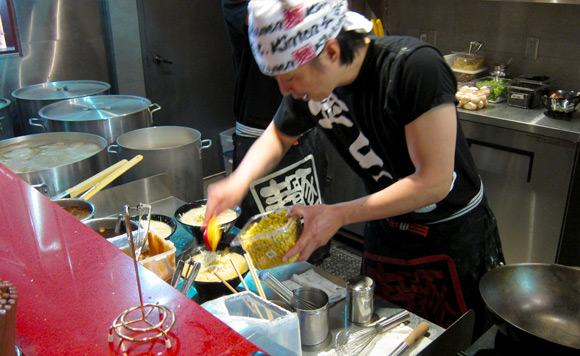 Most know ramen as the dirt-cheap instant packets of starch and salt (usually consumed straight out of the pot it was made in) from our days at school. But making fresh ramen is a finely-honed craft in Japan, where recipes are closely-guarded secrets. And though noodle shops like Ajisen and Kenzo have been around in Toronto for many years, it was only when Kinton opened back in May 2012 did I feel that the game was truly on.
Most know ramen as the dirt-cheap instant packets of starch and salt (usually consumed straight out of the pot it was made in) from our days at school. But making fresh ramen is a finely-honed craft in Japan, where recipes are closely-guarded secrets. And though noodle shops like Ajisen and Kenzo have been around in Toronto for many years, it was only when Kinton opened back in May 2012 did I feel that the game was truly on.
Since then, no less than five (with a sixth this Friday) four dedicated ramen-yas have opened up shop in the last seven months. Toronto, once starved for any non-instant noodle source, has suddenly been thrust into a realm where broth nuances and noodle alkalinity can be deliberated in a local context. I love it.
Of course, I had to learn a bit more about ramen first. Here are some Coles Notes I gathered as a primer. Please don’t take this as gospel. I only know enough to be dangerous.
THE NOODLE
Wheat flour, salt, water, and kansui (the alkaline water that gives ramen its texture and colour) are all that a ramen noodle recipe requires. The noodles most obviously have texture, but there is also taste. The nuances are subtle, but can sway an okay bowl of noodle to a great one. People talk about too much alkaline in the noodle and I haven’t really encountered this in my ramen bowls, but maybe you’ll pick up that metallic taste I associate with what a friend described as “the bitter taste of cheap Chinese egg-noodles.” The curl of a noodle can vary, and can even be straight. Noodle thickness can go from thin to thick, all coming down to preference and regional variances.
THE SOUP
The broths – most commonly pork, chicken, fish, miso bases – are generally salty and pack a flavour punch. The viscocity and umami of a broth is what distinguishes both kind and quality. Shio is a plain salt broth that should be relatively pale and clear. Shoyu is a broth with soy sauce added. It is a light and clear brown. Tonkotsu is a pork bone soup that is boiled for hours and should have a milky look. Miso is a cloudy soup, with a much heartier feel. Makes sense since it was developed in Hokkaido, which has a very cold clime.
THE TOPPINGS
 Toppings can include char siu, bean sprouts, scallion, corn, wood ear mushrooms, and of course, an egg. Pickled plum, cabbage, and fish cakes are also common. Most often, a bowl will include some of these toppings with the option to add others (for an additional fee, of course!). The char siu and the boiled egg can be specialties in their own right. If you’re lucky, they may even have onsen tamago (a slow-cooked custard-like preparation).
Toppings can include char siu, bean sprouts, scallion, corn, wood ear mushrooms, and of course, an egg. Pickled plum, cabbage, and fish cakes are also common. Most often, a bowl will include some of these toppings with the option to add others (for an additional fee, of course!). The char siu and the boiled egg can be specialties in their own right. If you’re lucky, they may even have onsen tamago (a slow-cooked custard-like preparation).
PREFERENCES
When I go around eating ramen, I have my default shio as a baseline, but will branch-out once that baseline has been established. I generally like thicker noodles with a decent chew. I can’t really distinguish (or maybe I like) the alkaline taste that people go on about. I love runnier eggs, but not too runny. I’ll generally opt for corn, just because. Why am I telling you this? Because all these ramen houses that I’ve eaten at these last months – they’re all good. And the reasons why you like one over another will pretty much be minutiae. But if you like (or hate) my minutiae, at least you know!
So, you ready?
A map will be forthcoming, once, you know, I fix that plugin.

January 17, 2013 at 3:21 pm
Is that list the order that you prefer them?
Looking forward to seeing your full write up/list. I am getting a bit confused with all of these Ramen spots opening/opened up and it will be good to have a reference post like this!
Personally hit up both Kinton and Santouka recently (Kinton twice) and looking forward to trying more spots!
January 17, 2013 at 3:45 pm
That is the order in which I ate at these restaurants (well, minus Ryoji), and, I think, that they opened. I’m a little sketchy on where A-OK fits on that time-line.
Thanks YLSF!
January 18, 2013 at 11:59 am
Raijin is just a disappointment to be honest, they pen fried the topping and pour them into the bowl. The problem is, the whole ramen now leave a taste of pen fried oil.